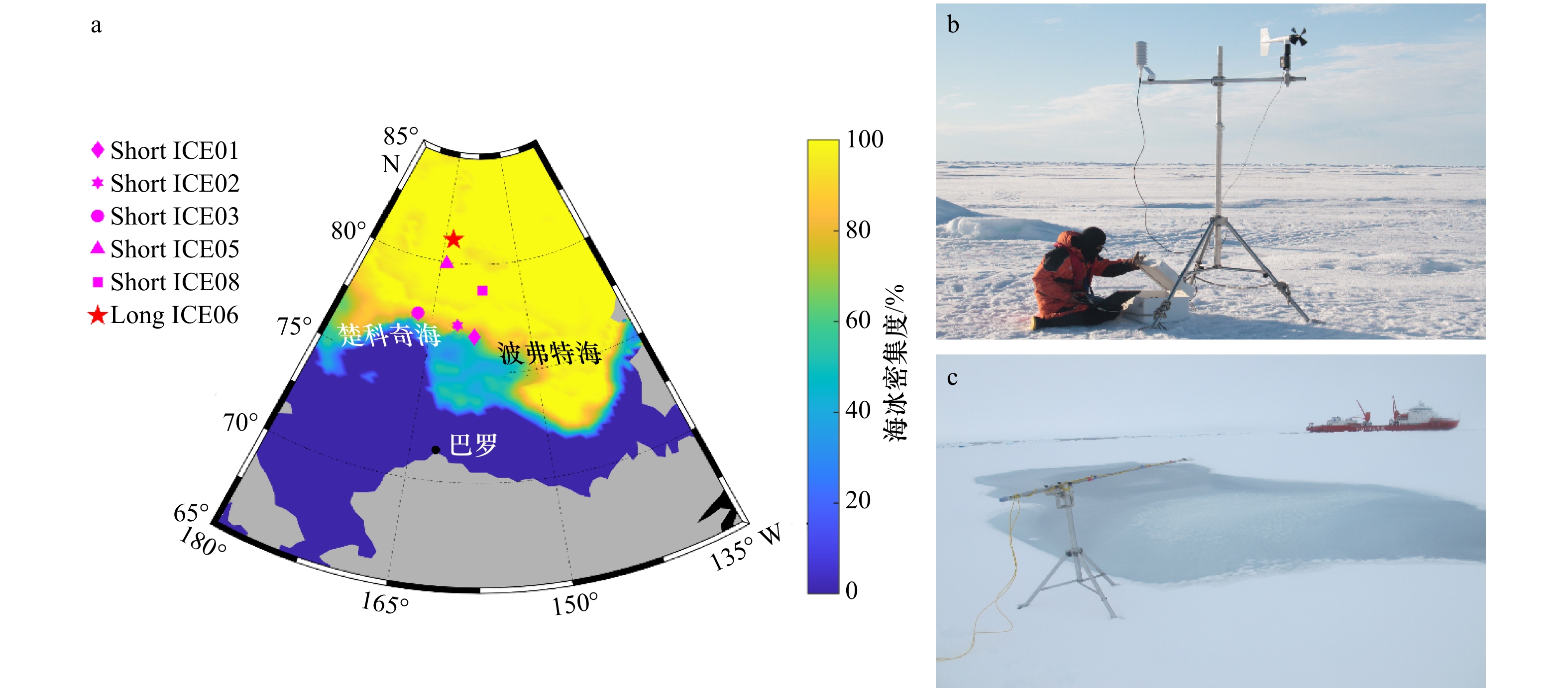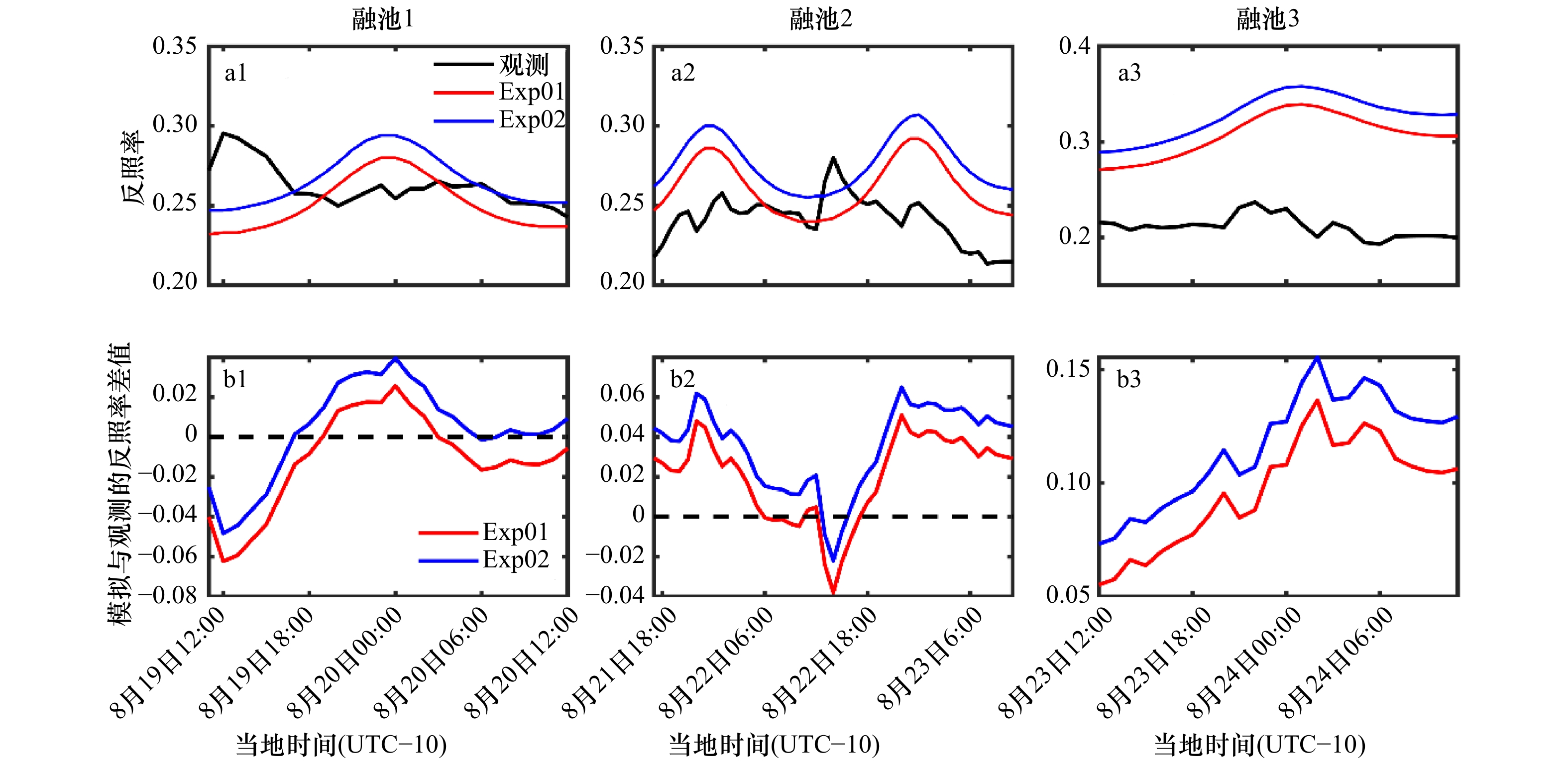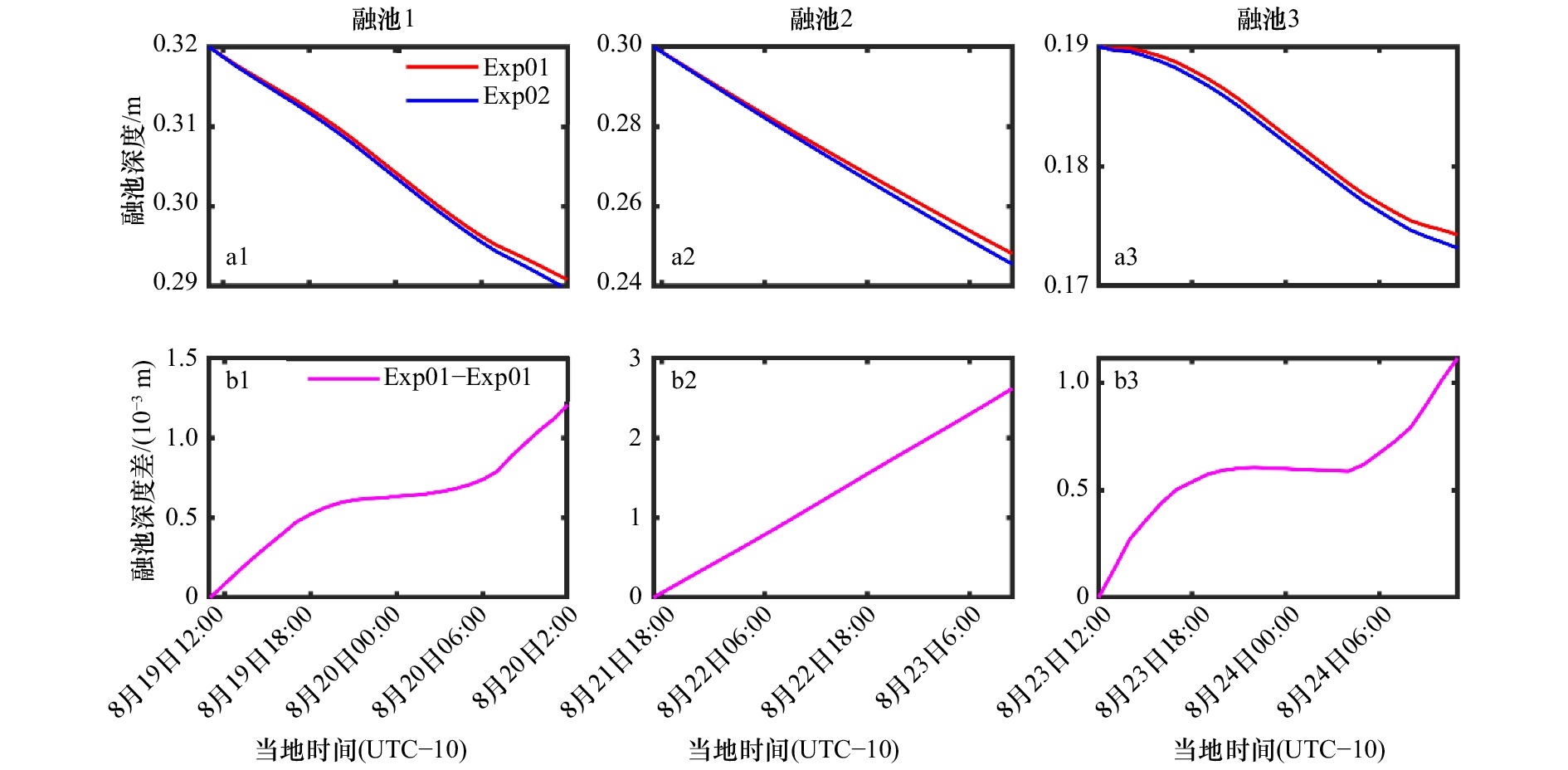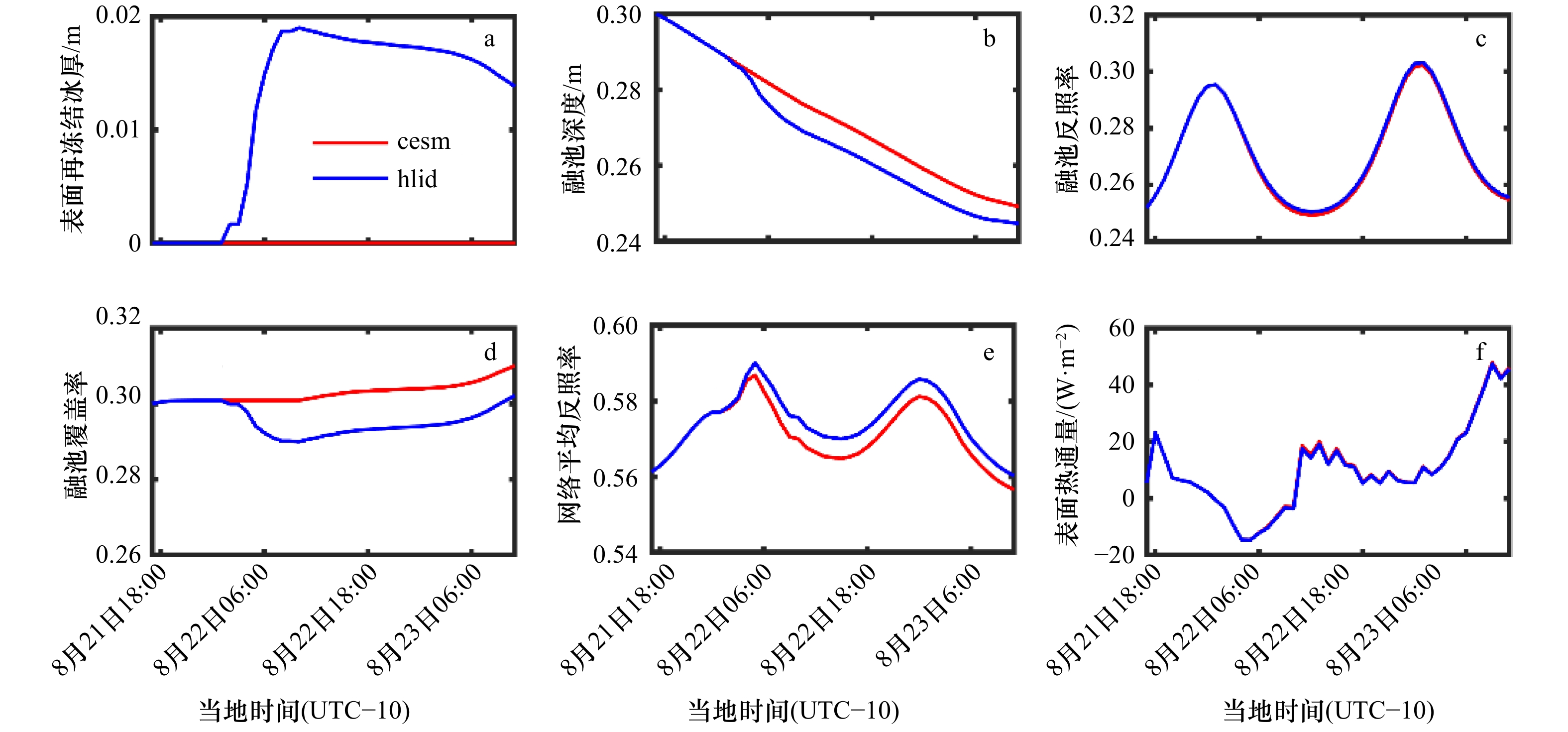Study on melt pond albedo based on Icepack sea ice column model
-
摘要: 基于Icepack一维海冰柱模式,以2014年中国第6次北极科学考察长期冰站ICE06的3个融池的辐射参量和气象参量的连续观测作为大气强迫数据,对融池反照率及相关参量进行了模拟。本文引入观测的融池深度及海冰厚度作为初始条件,通过考虑融池覆盖率的作用,改进了平整冰融池参数化方案中海冰干舷的计算,修正了冰上可允许的最大融池深度,成功实现了对融池参数变化的模拟;同时,还修正了入射辐射分量比例系数与对应反照率分量权重系数不一致的问题。标准试验中,模拟的3个融池的反照率与观测结果之间的平均误差分别为0.01、0.05和0.13;入射辐射比例的敏感性试验结果表明,当可见光辐射比例增大8%时,融池反照率的模拟结果增大了6%~8%;融池表面再冻结试验的结果显示,当再冻结冰层厚度小于2 cm时,模拟冰面反照率的增加不足0.006,由此引起的表面能量收支减少了约1.1 W/m2。本文研究指出,准确的入射辐射比例对于改善北极海冰反照率模拟是必要的;并指出目前模式仍存在融池表面再冻结参数化、热收支计算、表面吹雪效应等有待解决的问题。
-
关键词:
- 融池 /
- 反照率 /
- 融池深度 /
- Icepack海冰模式 /
- 模拟
Abstract: Based on one-dimensional sea ice column model Icepack, albedo and depth of melt pond were simulated. Atmospheric forcing data were collected from ICE06, a long-term ice station established during the Sixth Chinese National Arctic Research Expedition in 2014 in which the radiation and meteorological parameters of three melt ponds were continuously observed. In this paper, observed melt pond depth and thickness of sea ice under ponds were used as initial conditions. Furthermore, the calculation of sea ice freeboard in the melt pond scheme of level ice was improved by considering the effect of melt pond fraction. Consequently, by improving the formula of the maximum depth of melt pond above sea ice, simulation of melt pond albedo as well as other related parameters were successfully realized. Additionally, the inconsistency between the proportion coefficient of the incident solar radiation component and the weight coefficient of the corresponding albedo component was modified. The average errors between the simulated and observed albedo of the three ponds in the standard experiments were 0.01, 0.05 and 0.13, respectively. The sensitivity experiment results for the incident radiation proportion suggested that when the proportion of visible radiation increased by 8%, the simulation results of the melt pond albedo increased by 6%−8%. Results of the melt pond refreezing experiments suggested that when the thickness of lid ice is less than 0.02 m, the increase of simulated ice albedo is less than 0.006, resulting in a decrease of surface energy budget by about 1.1 W/m2. It is pointed out that providing an accurate proportion of incident radiation is necessary to improve the simulation of Arctic sea ice albedo. Furthermore, there are still some physical processes which need to be improved in Icepack/CICE model such as melt pond surface refreezing schemes, surface heat budget calculation, surface snow blowing effect and so on.-
Key words:
- melt pond /
- albedo /
- melt pond depth /
- Icepack sea ice model /
- simulation
-
图 1 第6次中国北极科学考察期间建立的冰站位置及2014年8月23日海冰密集度 (a)、ICE06上的气象观测站(b)和融池辐射通量观测(c)
Fig. 1 Locations of ice stations established during the Sixth Chinese National Arctic Research Expedition along with the sea ice concentration on August 23, 2014 (a), meteorological station (b) and melt pond radiation flux observation (c) of ICE06
图 4 观测期间融池表面的短波辐射通量(a1–a3)、基于观测的下行和上行短波辐射通量计算的反照率(b1–b3)和太阳高度角(c1–c3),其中太阳高度角由Icepack模式计算
Fig. 4 Surface shortwave radiation flux (a1–a3), albedo calculated using the observed downward and upward shortwave fluxes (b1–b3) and solar elevation angle (c1–c3) of melt ponds during observation, in which the solar elevation angle is calculated by Icepack
图 7 cesm和hlid融池再冻结参数化方案中,融池表面再冻结海冰厚度(a)、融池深度 (b)、融池反照率(c)、融池覆盖率(d)、网格平均反照率(e)和网格表面热通量(f)的模拟结果
Fig. 7 Simulation results of lid ice thickness (a), melt pond depth (b), melt pond albedo (c), melt pond fraction (d), grid box mean albedo (e), and surface heat flux (f) in the cesm and hlid refrozen schemes
表 1 第6次中国北极科学考察ICE06长期冰站的融池观测信息
Tab. 1 Melt pond observation information of the long term station ICE06 in the Sixth Chinese National Arctic Research Expedition
观测信息 融池1 融池2 融池3 位置 81.06°N,157.70°W 81.10°N,157.10°W 81.16°N,156.72°W 起止观测时间(UTC) 8月19日21:53至8月20日22:31 8月22日03:08至8月23日21:25 8月23日22:10至8月24日21:09 总观测时长/h 26 43 24 观测频率/s−1 60 10 10 上覆冰厚/cm 6~7 4 4 融池深度/cm 32 30 19 融池底部冰厚/m 1.5 1.5 1.5 天气状况 阴有雾 有雾、期间降雪 有雾、期间降雪 降雪开始时间 \ 2014年8月22日03:11 2014年8月23日22:10 降雪持续时间 \ 约42 h 约23 h 平均降雪速率/(kg·m−2·s−1) \ 6.61×10−5 1.33×10−4 降雪结束时融池周围冰面上的
新雪厚度/cm0 5.0 5.5 注:\表示观测期间未降雪。 表 2 Icepack模式数值试验设置
Tab. 2 Numerical experiments configuration of Icepack model
设置 Exp01(标准试验) Exp02 可见光与近红外比例 0.78∶0.22(太阳可见) 0.85∶0.15(太阳不可见) 直射与漫射辐射比例 0.10∶0.90(云量较大,漫射辐射为主) 初始冰厚 1.5 m 初始融池深度 取观测值(表1) 初始融池覆盖率 30% 融池参数化方案 基于平整冰的lvl方案 反照率分类 CCSM3反照率类型 反照率参数化方案 Delta-Eddington 热力学参数化方案 糊状层热力学方案 -
[1] Curry J A, Schramm J L, Ebert E E. Sea ice-albedo climate feedback mechanism[J]. Journal of Climate, 1995, 8(2): 240−247. doi: 10.1175/1520-0442(1995)008<0240:SIACFM>2.0.CO;2 [2] Eicken H, Grenfell T C, Perovich D K, et al. Hydraulic controls of summer Arctic pack ice albedo[J]. Journal of Geophysical Research: Oceans, 2004, 109(C8): C08007. [3] Pirazzini R. Factors Controlling the Surface Energy Budget Over Snow and Ice[M]. Helsinki: Finnish Meteorological Institut, 2008. [4] Schröder D, Feltham D L, Flocco D, et al. September Arctic sea-ice minimum predicted by spring melt-pond fraction[J]. Nature Climate Change, 2014, 4(5): 353−357. doi: 10.1038/nclimate2203 [5] Tucker III W B, Gow A J, Meese D A, et al. Physical characteristics of summer sea ice across the Arctic Ocean[J]. Journal of Geophysical Research: Oceans, 1999, 104(C1): 1489−1504. doi: 10.1029/98JC02607 [6] Polashenski C, Perovich D, Courville Z. The mechanisms of sea ice melt pond formation and evolution[J]. Journal of Geophysical Research: Oceans, 2012, 117(C1): C01001. [7] Perovich D K, Polashenski C. Albedo evolution of seasonal Arctic sea ice[J]. Geophysical Research Letters, 2012, 39(8): L08501. [8] Webster M A, Rigor I G, Perovich D K, et al. Seasonal evolution of melt ponds on Arctic sea ice[J]. Journal of Geophysical Research: Oceans, 2015, 120(9): 5968−5982. doi: 10.1002/2015JC011030 [9] Perovich D K, Tucker III W B, Ligett K A. Aerial observations of the evolution of ice surface conditions during summer[J]. Journal of Geophysical Research: Oceans, 2002, 107(C10): SHE 24-1−SHE 24-14. [10] Tschudi M A, Curry J A, Maslanik J A. Airborne observations of summertime surface features and their effect on surface albedo during FIRE/SHEBA[J]. Journal of Geophysical Research: Atmospheres, 2001, 106(D14): 15335−15344. doi: 10.1029/2000JD900275 [11] Lu Peng, Li Zhijun, Cheng Bin, et al. Sea ice surface features in Arctic summer 2008: Aerial observations[J]. Remote Sensing of Environment, 2010, 114(4): 693−699. doi: 10.1016/j.rse.2009.11.009 [12] 王明锋, 苏洁, 李涛, 等. 基于无人机观测的北极冰面融池及冰面粗糙度信息提取方法研究[J]. 极地研究, 2017, 29(4): 436−445.Wang Mingfeng, Su Jie, Li Tao, et al. Study on the method of extracting Arctic melt pond and roughness information on sea ice surface based on UAV observation[J]. Chinese Journal of Polar Research, 2017, 29(4): 436−445. [13] Rösel A, Kaleschke L, Birnbaum G. Melt ponds on Arctic sea ice determined from MODIS satellite data using an artificial neural network[J]. The Cryosphere, 2012, 6(2): 431−446. doi: 10.5194/tc-6-431-2012 [14] Li Qing, Zhou Chunxia, Zheng Lei, et al. Monitoring evolution of melt ponds on first-year and multiyear sea ice in the Canadian Arctic Archipelago with optical satellite data[J]. Annals of Glaciology, 2020, 61(82): 154−163. doi: 10.1017/aog.2020.24 [15] Perovich D K, Grenfell T C, Light B, et al. Seasonal evolution of the albedo of multiyear Arctic sea ice[J]. Journal of Geophysical Research: Oceans, 2002, 107(C10): SHE 20-1−SHE 20-13. [16] Hohenegger C, Alali B, Steffen K R, et al. Transition in the fractal geometry of Arctic melt ponds[J]. The Cryosphere, 2012, 6(5): 1157−1162. doi: 10.5194/tc-6-1157-2012 [17] Perovich D K, Grenfell T C, Light B, et al. Transpolar observations of the morphological properties of Arctic sea ice[J]. Journal of Geophysical Research: Oceans, 2009, 114(C1): C00A04. [18] Morassutti M P, LeDrew E F. Albedo and depth of melt ponds on sea-ice[J]. International Journal of Climatology: A Journal of the Royal Meteorological Society, 1996, 16(7): 817−838. [19] Nicolaus M, Katlein C, Maslanik J, et al. Changes in Arctic sea ice result in increasing light transmittance and absorption[J]. Geophysical Research Letters, 2012, 39(24): L24501. [20] Hanesiak J M, Barber D G, de Abreu R A, et al. Local and regional albedo observations of Arctic first-year sea ice during melt ponding[J]. Journal of Geophysical Research: Oceans, 2001, 106(C1): 1005−1016. doi: 10.1029/1999JC000068 [21] Fetterer F, Untersteiner N. Observations of melt ponds on Arctic sea ice[J]. Journal of Geophysical Research: Oceans, 1998, 103(C11): 24821−24835. doi: 10.1029/98JC02034 [22] Lei Ruibo, Tian-Kunze Xiangshan, Leppäranta M, et al. Changes in summer sea ice, albedo, and portioning of surface solar radiation in the Pacific Sector of Arctic Ocean during 1982–2009[J]. Journal of Geophysical Research: Oceans, 2016, 121(8): 5470−5486. doi: 10.1002/2016JC011831 [23] Lu Peng, Leppäranta M, Cheng Bin, et al. Influence of melt-pond depth and ice thickness on Arctic sea-ice albedo and light transmittance[J]. Cold Regions Science and Technology, 2016, 124: 1−10. doi: 10.1016/j.coldregions.2015.12.010 [24] Comiso J C, Parkinson C L, Gersten R, et al. Accelerated decline in the Arctic sea ice cover[J]. Geophysical Research Letters, 2008, 35(1): L01703. [25] Stroeve J, Maslowski W. Arctic sea ice variability during the last half century[M]//Climate Variability and Extremes During the Past 100 Years. Dordrecht: Springer, 2008: 143−154. [26] Stroeve J C, Kattsov V, Barrett A, et al. Trends in Arctic sea ice extent from CMIP5, CMIP3 and observations[J]. Geophysical Research Letters, 2012, 39(16): L16502. [27] Flocco D, Feltham D L, Turner A K. Incorporation of a physically based melt pond scheme into the sea ice component of a climate model[J]. Journal of Geophysical Research: Oceans, 2010, 115(C8): C08012. [28] Flocco D, Schroeder D, Feltham D L, et al. Impact of melt ponds on Arctic sea ice simulations from 1990 to 2007[J]. Journal of Geophysical Research: Oceans, 2012, 117(C9): C09032. [29] Hunke E C, Hebert D A, Lecomte O. Level-ice melt ponds in the Los Alamos sea ice model, CICE[J]. Ocean Modelling, 2013, 71: 26−42. doi: 10.1016/j.ocemod.2012.11.008 [30] Lüpkes C, Gryanik V M, Rösel A, et al. Effect of sea ice morphology during Arctic summer on atmospheric drag coefficients used in climate models[J]. Geophysical Research Letters, 2013, 40(2): 446−451. doi: 10.1002/grl.50081 [31] Ingram W J, Wilson C A, Mitchell J F B. Modeling climate change: An assessment of sea ice and surface albedo feedbacks[J]. Journal of Geophysical Research: Atmospheres, 1989, 94(D6): 8609−8622. doi: 10.1029/JD094iD06p08609 [32] Collins W D, Hackney J K, Edwards D P. An updated parameterization for infrared emission and absorption by water vapor in the National Center for Atmospheric Research Community Atmosphere Model[J]. Journal of Geophysical Research: Atmospheres, 2002, 107(D22): ACL 17-1−ACL 17-20. [33] Schramm J L, Holland M M, Curry J A, et al. Modeling the thermodynamics of a sea ice thickness distribution: 1. Sensitivity to ice thickness resolution[J]. Journal of Geophysical Research: Oceans, 1997, 102(C10): 23079−23091. doi: 10.1029/97JC01297 [34] Briegleb B P, Bitz C M, Hunke E C, et al. Scientific description of the sea ice component in the community climate system model, version 3[R]. NCAR/TN-463+STR, Boulder, CO, USA: NCAR, 2004: 70. [35] Briegleb B P, Light B. A delta-eddington mutiple scattering parameterization for solar radiation in the sea ice component of the community climate system model[R]. NCAR Tech. Note NCAR/TN-472+ STR, Boulder, Colorado: NCAR, 2007: 1−108. [36] Briegleb B P. Delta-Eddington approximation for solar radiation in the NCAR community climate model[J]. Journal of Geophysical Research: Atmospheres, 1992, 97(D7): 7603−7612. doi: 10.1029/92JD00291 [37] Wu Shuqiang, Zeng Qingcun, Bi Xunqiang. Modeling of Arctic sea ice variability during 1948–2009: Validation of two versions of the Los Alamos sea ice model (CICE)[J]. Atmospheric and Oceanic Science Letters, 2015, 8(4): 215−219. doi: 10.1080/16742834.2015.11447262 [38] 刘骥平, 雷瑞波, 宋米荣, 等. 适应极地快速变化海冰模式的研发与挑战[J]. 大气科学学报, 2021, 44(1): 12−25.Liu Jiping, Lei Ruibo, Song Mirong, et al. Development and challenge of sea ice model adapting to rapid polar sea ice changes[J]. Transactions of Atmospheric Sciences, 2021, 44(1): 12−25. [39] Taylor P D, Feltham D L. A model of melt pond evolution on sea ice[J]. Journal of Geophysical Research: Oceans, 2004, 109(C12): C12007. doi: 10.1029/2004JC002361 [40] Cheng Bin, Zhang Zhanhai, Vihma T, et al. Model experiments on snow and ice thermodynamics in the Arctic Ocean with CHINARE 2003 data[J]. Journal of Geophysical Research: Oceans, 2008, 113(C9): C09020. [41] Flocco D, Feltham D L, Bailey E, et al. The refreezing of melt ponds on Arctic sea ice[J]. Journal of Geophysical Research: Oceans, 2015, 120(2): 647−659. doi: 10.1002/2014JC010140 [42] CICE-Consortium/Icepack: Icepack 1.2. 4 (Version 1.2. 4)[EB/OL]. (2020−12−18)[2021−04−10]. http://doi.org/10.5281/zenodo.4358418. [43] Holland M M, Bailey D A, Briegleb B P, et al. Improved sea ice shortwave radiation physics in CCSM4: The impact of melt ponds and aerosols on arctic sea ice[J]. Journal of Climate, 2011, 25(5): 1413−1430. [44] 王传印, 苏洁. CICE海冰模式中融池参数化方案的比较研究[J]. 海洋学报, 2015, 37(11): 41−56.Wang Chuanyin, Su Jie. Comparison of melt pond parameterization schemes in CICE model[J]. Haiyang Xuebao, 2015, 37(11): 41−56. [45] Eicken H, Bluhm B A, Collins R E, et al. Field techniques in sea-ice research[M]//Shen H. Cold Regions Science and Marine Technology. Paris, France: Eolss Publishers, 2014: 1−20. [46] Semtner Jr A J. A model for the thermodynamic growth of sea ice in numerical investigations of climate[J]. Journal of Physical Oceanography, 1976, 6(3): 379−389. doi: 10.1175/1520-0485(1976)006<0379:AMFTTG>2.0.CO;2 [47] Bitz C M, Lipscomb W H. An energy-conserving thermodynamic model of sea ice[J]. Journal of Geophysical Research Oceans, 1999, 104(C7): 15669−15677. doi: 10.1029/1999JC900100 [48] Feltham D L, Untersteiner N, Wettlaufer J S, et al. Sea ice is a mushy layer[J]. Geophysical Research Letters, 2006, 33(14): L14501. doi: 10.1029/2006GL026290 [49] Grenfell T C, Perovich D K. Spectral albedos of sea ice and incident solar irradiance in the southern Beaufort Sea[J]. Journal of Geophysical Research: Oceans, 1984, 89(C3): 3573−3580. doi: 10.1029/JC089iC03p03573 [50] Rosati A, Miyakoda K. A general circulation model for upper ocean simulation[J]. Journal of Physical Oceanography, 1988, 18(11): 1601−1626. doi: 10.1175/1520-0485(1988)018<1601:AGCMFU>2.0.CO;2 [51] Lu P, Cao X, Wang Qingkai, et al. Impact of a surface ice lid on the optical properties of melt ponds[J]. Journal of Geophysical Research: Oceans, 2018, 123(11): 8313−8328. doi: 10.1029/2018JC014161 [52] Lei Ruibo, Cheng Bin, Heil P, et al. Seasonal and interannual variations of sea ice mass balance from the Central Arctic to the Greenland Sea[J]. Journal of Geophysical Research: Oceans, 2018, 123(4): 2422−2439. doi: 10.1002/2017JC013548 [53] Malinka A, Zege E, Istomina L, et al. Reflective properties of melt ponds on sea ice[J]. The Cryosphere, 2018, 12(6): 1921−1937. doi: 10.5194/tc-12-1921-2018 [54] Curry J A, Schramm J L, Perovich D K, et al. Applications of SHEBA/FIRE data to evaluation of snow/ice albedo parameterizations[J]. Journal of Geophysical Research: Atmospheres, 2001, 106(D14): 15345−15355. doi: 10.1029/2000JD900311 -





 下载:
下载:






